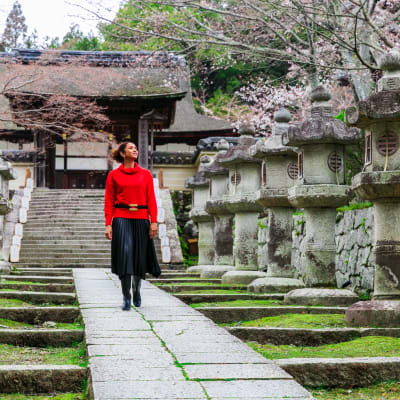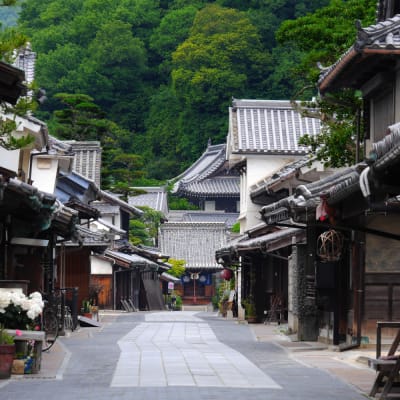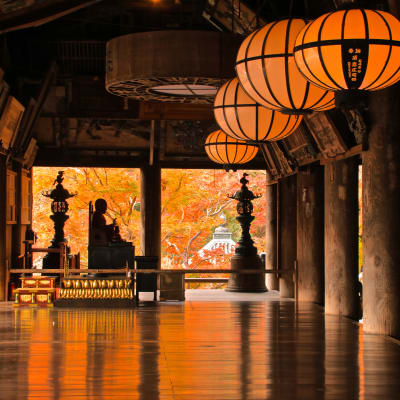
Temple Stays Temple Hotel Shoureki-ji A private spiritual retreat in Kyoto’s serene northern mountains
Enjoy warm hospitality and explore ancient spiritual traditions
Kyoto City is Japan’s cultural heart, drawing visitors to its historic streets and renowned temples. For a deeper understanding of Kyoto’s cultural and spiritual heritage, head to the quiet northern region. Explore rural towns and charming coastal villages, and enjoy authentic temple experiences.
Shoureki-ji Temple is nestled in the mountains near Ayabe, about two hours north of Kyoto by train. The temple welcomes guests of all faiths to relax, recharge, and experience temple life. The temple accommodates just one group at a time to experience a shukubo temple stay, for a tailored, personalized retreat. Enjoy the warm hospitality of the head priest and his wife, who prepare traditional meals and guide visitors through temple experiences such as morning prayers and copying sutras.

A moment of quiet prayer.
© OTERA STAY
The temple is located in the town of Ayabe, nestled amongst the mountains of northern Kyoto. The location offers convenient access to Kyoto’s beautiful coast, with quiet beaches, quaint fishing towns, and views over Amanohashidate, a striking, forested sandbar whose name means “bridge to heaven.”
Relax at a private retreat
Shoureki-ji Temple is located in a quiet residential corner of Ayabe, and has views of the Yura River. The temple was founded in 942 and enshrines a figure of Kannon, the Bodhisattva of Compassion. Most of the temple buildings date to the late Edo period (1603–1867).

Relax in a self-contained accommodation at the temple.
© OTERA STAY
The comfortable, self-contained guest quarters comprise three large rooms which can accommodate up to eight people. The residence was built around 100 years ago and keeps its traditional charm, with the added convenience of modern bathrooms and Wi-Fi. Rooms are separated by hand-painted fusama (sliding doors), which can be opened up to create one large space, with views of the river and nearby mountains.
Upon arrival, you are greeted by the temple’s priest and guided to the accommodation. Over tea and sweets the priest will introduce the temple, and discuss experiences and activities on offer to tailor the stay to your needs.
Taste the seasons
Mealtimes are a highlight at Shoureki-ji. The head priest prepares kaiseki meals of delicate, seasonal dishes for a feast that is as much for the eyes as the tastebuds. The first part of dinner is a collaborative affair. Stroll the temple grounds, gathering seasonal ingredients and decorations for the hassun, a selection of eight appetizers. The process of gathering fresh ingredients will help you to connect with the natural environment around the temple.

The meal includes a whole Shamo chicken, each part prepared to enhance its texture and flavor.
© OTERA STAY
The centerpiece of the evening meal is an entire Shamo chicken, a prized breed of game fowl, raised at a local farm. Each part of the chicken is carefully prepared to enhance its flavor and texture, from marinating in miso to smoking with applewood. Nothing is wasted, following the Buddhist practice of showing respect and appreciation for all living things. Guests can arrange alternatives to chicken with prior notice.
Alcoholic beverages are available with dinner, including sake from the Wakamiya Sake Brewery directly across the river, or from the temple’s own collection. Guests can also savor the temple’s homemade liqueurs made from seasonal fruits such as Japanese apricots.

Meals are a highlight of a stay at Shoureki-ji Temple.
© OTERA STAY
A new day commences with a hearty breakfast of rice, vegetables, fish, and other dishes, served on beautifully lacquered tableware. Weather permitting, you can enjoy breakfast on the deck in the temple grounds.
Music to calm the mind
After the morning prayers, the head priest can offer lessons on how to play various narashimono, the musical instruments used at temples. These include the bell, hand gong, small symbols, metal gong, conch, and taiko drum. The sounds are meant to set the rhythm and tone for chanting sutras, and to help focus the mind on prayer.

Try playing the traditional instruments used at the temple.
© OTERA STAY
Inner peace and spiritual cleansing
Meditation is said to reduce stress and enhance concentration. Zazen, seated meditation, is meant to balance body and mind, and free practitioners from the distractions and stresses of the outside world. At Shoureki-ji Temple, you can try chikurin zazen, a meditation session in a bamboo forest. The sounds of the whispering wind, birdsong, and the distant murmuring river help to relax the mind. You can also experience zazen meditation inside, sitting on the temple's tatami mat flooring. The practice of zazen focuses on breathing and calms the mind.

Relax in nature, with a meditation experience in a bamboo forest.
© OTERA STAY
For a deeper understanding of the temple’s spiritual practices, guests can participate in a guided Goma fire ceremony. After you write your prayers and wishes on wooden tablets, they are burned in a fire which represents Buddha’s wisdom. The ceremonial discarding of worldly desires is said to be both spiritually and psychologically cleansing.

The Goma fire ceremony is both spiritually and psychological cleansing.
© OTERA STAY
Trek and cycle to explore local culture
The hiking trails on nearby Mt. Ine offers an opportunity to experience the culture and spiritual practices of Ayabe in the fresh mountain air. From the summit at 160 meters, you can take in the town, the Yura River, and the surrounding countryside. A direct path up the mountain to Akiba Shrine takes about 45 minutes.
A more challenging course weaves circuitously, connecting 88 miniature shrines that contain stone Buddhist statues. This trek takes inspiration from the 1,200-kilometer pilgrimage in Shikoku which Kobo Daishi (774–835, also known as Kukai), the founder of esoteric Shingon Buddhism, made in the ninth century. This scaled-down version of the Shikoku pilgrimage takes around 2 hours.

The temple has bicycles for guests to explore the local area.
© OTERA STAY
The temple can organize other activities, including making goma dofu, a sesame-flavored tofu, or trying nagashi somen, a summertime staple in Japan that involves catching chilled noodles with chopsticks as they are washed with water down a cut section of bamboo. For more active pursuits, take a guided canoe ride on the Yura River, or borrow one of the temple bicycles to explore the local area. Most activities can be organized with a few days’ notice.
Make your own traditional washi paper
Kurotani washi paper has an 800-year history. The durable paper was originally for practical use, typically used to make paper screen doors and lanterns. Today, Kurotani washi is a specialty material for postcards, writing paper, and art paper. Visitors to the quaint, quiet village of Kurotani can join a workshop at the Kurotani Washi Center to make a set of postcards using traditional methods preserved over the centuries. Kurotani is a short bus or taxi ride from Ayabe Station. Visitors can arrange an English-speaking guide for a tour of Kurotani and Ayabe, including the washi making experience.

Learn the art of making washi paper at Kurotani Washi Center.
© OTERA STAY
Walk the "Bridge to Heaven"
Ayabe is a convenient base for exploring Kyoto’s quieter side along the Sea of Japan coast. Among the area's more popular attractions is Amanohashidate, a narrow sandbar covered with around 5,000 pine trees that stretches across Miyazu Bay. Amanohashidate means "bridge to heaven," and it was so named because when viewed from one of the mountains on either end (at Amanohashidate View Land or Kasamatsu Park), the sandbar appears to reach the sky, connecting heaven and earth. Visitors can walk the sandbar on foot or rent a bicycle around Amanohashidate Station. Sightseeing cruises on the bay offer a different perspective of the breathtaking natural scenery.

Enjoy the view of the “bridge to heaven”, from Amanohashidate View Land.
A short walk from the north end of Amanohashidate is Motoise Kono Shrine. The two komainu (mythical lion-dogs) that guard the shrine date back to the Kamakura period (1185–1333). According to local legend, they used to come alive at night and rampage through the town. Next to the shrine, the Kasamatsu Cable Car takes visitors up to the Amanohashidate Observatory for views across the bay.
From Ayabe Station, the journey to Amanohashidate takes under two hours by train. There are several rental car businesses in Ayabe. Shoureki-ji Temple can assist with renting a car for exploring the wider area.
Measures against the spread of COVID-19
Temple Hotel Shoureki-ji is taking measures to prevent the spread of COVID-19, including regularly disinfecting and ventilating rooms and shared spaces, and making alcohol hand sanitizers available. The accommodation is limited to one group per stay, ensuring privacy and social distancing.
Please note that certain programs and events may have been canceled or temporarily suspended due to COVID-19. Please check the temple website or inquire in advance.



























































